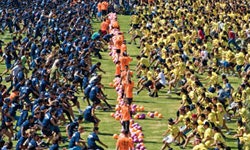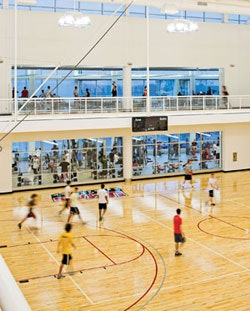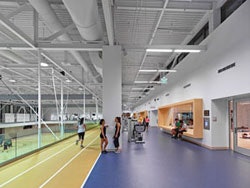The last few years have been a mixed bag for the recreation industry. The recession brought with it budget cuts that forced many recreation departments to get creative.

The last few years have been a mixed bag for the recreation industry. The recession brought with it budget cuts that forced many recreation departments to get creative. Throw in a culture shift that focuses on competition and being the best, technological advances that put instant access to digital entertainment right at users' fingertips, and where do recreation programs fit in?
John Crompton, distinguished professor at Texas A&M University's Department of Recreation, Park and Tourism Sciences, has spent nearly a half-century working in and researching recreation. "In the '70s when we did studies in cities and asked the question, 'Has someone in your household participated in a public recreation program in the last month?' we'd get 12 to 15 percent indicating yes. Today, that number is typically around 3 to 5 percent of households. There has been a dramatic cutback in the proportion of households that engage in recreation amenities."
"Times have changed," agrees Dale Weigandt, superintendent for the River Road (Ore.) Park and Recreation District, who has experienced a lot in his 39 years with the district. "The entire concept of programming has changed."
While the programs may have changed, the fundamental purpose of recreation services has not. Recreation programs, whether municipal or collegiate, are not trying to turn a profit or turn out topnotch athletes. They are trying to provide quality programs and services to improve the quality of life for their communities.
"The average taxpayer looks at something like softball or soccer and says, 'That's a silly, trivial activity, isn't it? How does that compare to police protection?' " says Crompton. "It is a silly, trivial activity, but it satisfies very important human needs. It's about socialization, building self-esteem, building character."
Building self-esteem may not be on the minds of most participants who sign up for recreation programs. When people decide to participate in any activity, the reasons are more tangible and immediate - perhaps they want to get to know new people or are signing up because their friends are, they want to learn a new skill, or, most simply, they enjoy playing a particular sport.
"There are a variety of benefits people are looking to get out of recreation," says Daniel Elkins, who spent seven years in municipal parks and recreation before returning to graduate school to pursue a Ph.D. in leisure behavior and currently serves as associate professor in Illinois State University's Kinesiology and Recreation Department. "I've found that college students are mostly motivated to participate due to competency mastery factors - the element of competition, the element of getting better at something. The social factor is another important one."
A successful recreation program is one that identifies whatever motivates participants to come through the program's door, and surveys and evaluations of program participants can provide valuable feedback. Knowing why participants come to an activity allows an organization to improve the program quality and increase satisfaction among current participants, but that feedback provides little help when an organization is seeking to attract people who aren't participating.
Weigandt recalls a particular incident that occurred when he first became River Road's adult programmer in 1979. "This guy called me up and said, 'Hey, you guys are a bunch of crap. I looked at your programs, and you've got nothing but belly dancing. You don't have anything for me.' I asked, 'Sir, what would you like to do?' 'I want to do fly-tying. All you got in here is belly dancing.'
"Belly dancing was just one class; he focused in on that. But he was right. We didn't have anything for him. Every person has his or her own reason for coming, and if you can put out enough different reasons for people to be there, you're probably going to hit a good assortment of folks. You should never sit down and think, 'Wow, look at all the people here, we've really got it together.' Who aren't you hitting?"

Finding out why people aren't coming to your programs isn't easy. It's like saying, "If you're not here, please raise your hand." It's a bit easier in the campus setting, Elkins notes, where the community is more defined and programmers have access to student e-mail lists and other information. "It's very difficult if you're looking at municipal," he says. "The only way to get feedback from nonparticipants is to do a community-wide survey."
Surveys can be time-consuming and expensive, but they are just one of many ways to identify areas of need in a community. Paging through newspapers, browsing the web, and attending conferences are all ways to keep tabs on the latest trends and identify programs that might interest people.
Frank Olivieri became manager of the Melrose (Mass.) Recreation Department in 2009, and has seen participation rates climb from just 2,500 participants in FY 2008 to an estimated 10,500 in FY 2012. "We're always out there with evaluation forms," he says. "Trying to get feedback, hear what people want, find out what they want to see. It doesn't always work in our favor. We can't provide everything, of course."
No organization can fulfill all of the recreation desires of a community; nor should it try. Today, recreation organizations face competition from various other programs - health clubs, youth sports leagues - that are better able to identify a particular motivation and specialize in accommodating it. Recreation programs should not aim to compete with these specialized programs, but rather complement them. "A lot of kids and families these days are almost maxed out," says Olivieri. "You really have to try to work around other groups that already exist in the city and fill unfilled needs. We have a very large nonprofit soccer organization in town. We don't try to compete with them; we don't run a soccer program."
Instead, the recreation department looked for other community needs to fill. "We noticed that our middle school programming was almost nonexistent," Olivieri explains. "We stepped in as a department and we now run all of the middle school after-school programs. We run the clubs, athletics, music and art programs. That need was there, and nobody was filling it yet."
According to Olivieri, the department looks not just at the needs of the community but the opportunities within the community. "We'd see an ad in the paper for one person offering a piano lesson. And two weeks later, someone was offering an art class. We try to pull instructors together and offer those programs," he says. "We've built a lot of partnerships off struggling businesses. It's something any community can do, it's just identifying these opportunities."
Utilizing community resources is also a great alternative for an organization that doesn't have the resources to meet the demands of its participants. "This is something that I did in the early '90s," says Elkins, referring to his time working in municipal recreation. "We didn't have a place to do martial arts, and we knew there was a need, so we developed a relationship with another park district. We got it done and gave it to our participants. Partnerships and collaborations are a way to focus on what you're good at but still provide what your participants want."
Providing the programs that people want, though, is only useful if they know about them. "I love basketball," says Marc Iturriaga, associate director of campus recreation and business development at the University of Waterloo. "I play three times a week. You tell me there's basketball, I'll find it. But we often spend a lot of energy promoting to people like me, which is a waste of energy."
"There are some good marketing people in recreation organizations that do everything they can - digital signage, brochures, tweets," adds Elkins. "The problem is, if it's on a website, people have to go to a website to see that it exists. And if they're not following the agency on Twitter, they're not going to get that tweet."
Despite the recreation program's efforts, Iturriaga says that word of mouth is still the driving factor in participation. "People play because they know someone who plays. We've got to find ways to find the people who are going to find the people." A big part of that comes from the instructors - Iturriaga estimates that students teach 85 to 90 percent of Waterloo's programs. "They spread the word, they build the community feel of the leagues or fitness classes."

In Melrose, Olivieri has also found that indirect connections are more effective than direct advertising in raising awareness of programs. "We started putting all of our programs into a seasonal brochure, not just including ourselves, but trying to tie in other businesses and events going on throughout the city. People who were looking to advertise or a nonprofit hosting a free event were contacting us. Now the community realizes that to get a big bulk of the listings - which you can't really get in one spot - they can visit our website or look through our brochure."
And while they're browsing for one activity, they might find a few others that pique their interest. River Road has had success with a similar strategy, Weigandt says. "One of the ways we've found to expand our program is to run special events, like concerts in the park, carnivals, seasonal events. Things to bring people here, and then they can see all the other opportunities."
Finding the right programs to attract new participants is only half the battle. "Constraints certainly play a big role," says Elkins, who has spent a good portion of his career studying why people choose not to participate in leisure activities. Anyone in a municipal recreation department can quickly identify some of the most common barriers. "Time is such a factor," says Weigandt, "And it isn't a kid's time, it's the parent's time. You've got a lot of single parents and parents with a schedule. They don't have the time to get the kids there."
A great program should not be doomed by its scheduling - either the time of day or frequency. "What we do with a program is try it on one night," says Weigandt, "and if it doesn't work, we don't kill the program, we bring it back on a different day. You have to try as many different options as you can and promote them in different ways."
Cost is the second major issue recreation organizations face - struggling to find a price point that doesn't deter consumers but also covers their own costs. Increasing recreation participation in Melrose was accompanied by an increase of scholarships, from just five in 2008 to 150 in 2012, supported primarily by donations from private businesses and other organizations.
"We want our students to be able to participate in the program that they want to without cost being the reason they choose one over another," says Iturriaga, using hockey and dodgeball as an example. Although the costs to run a hockey program far exceed those for dodgeball, both programs are offered for the same $25 fee.
"If it's something they're really interested in and you put it at a time when they can do it, they're going to show up," Weigandt says.
Time, cost and location are all barriers that recreation organizations can control, but internal or interpersonal constraints are more difficult. People are not willing to pay as much for a program they're not truly interested in, or aren't sure they will enjoy. "We could increase our ice hockey fee easily," says Iturriaga. "In the long run, we're going to get way more revenue, but we'll lose a lot of participants. We're going to get the diehards who know how expensive it is to play hockey and are willing to pay that price, but the people who have never played say, 'Forget it.' They don't even know if they're going to like it."
"A lot of people don't like going to health clubs by themselves," adds Elkins. "They may not be aware of how to use equipment, they may be shy or have an attitude that prevents them from walking into a place and saying, 'I've never been here before. I'd like to use this equipment, but I have no idea where to begin.' Some people just don't have that type of personality."
Recreation programmers can't change the personalities of their potential participants, but they can find ways to mitigate the barriers. "No matter how much I advertise, it's the power of having a friend say, 'Come do this with me,' " says Iturriaga. "We try to promote getting people to get a friend to sign up with them."
The social aspect of recreation programs can be an asset or a hurdle, depending on how an organization promotes itself. Olivieri used peer pressure as an opportunity to boost recreation in Melrose. "We offered very inexpensive programming for 2- to 10-year-olds; $24 for an entire summer," he says. "It got people to our park. We ran little pocket programs, a learn-to-throw program, a storytime program, things like that. Because of the price, we'd get 15, 20 or 30 people signing up. They'd go to the park, do their program, and then stay. People weren't just going to a program for an hour; they were staying for four or five hours. We'd have people at the park, staying because other people were there. The rest of the community saw that and they wanted to be a part of it. People who weren't doing these programs just wanted to come down and be with their friends."
There's power in numbers, but there's also power in knowledge. Giving participants as much information as possible about a particular activity so that they know what to expect can give them the added confidence to act. "We used to have Leagues A, B and C," says Iturriaga of the University of Waterloo's rec basketball program. "If you used to play basketball in high school, you'll know what that means, but if you've never played basketball before, those letters mean nothing to you. We changed the names to Beginner, Intermediate, Advanced and All-Star. Just from that change in names, we saw a huge influx in student participation."
Offering trial classes or online introductions, or inviting people to observe an activity can help push someone from interest to action, but even participants who are interested enough in signing up for a program can face barriers that deter them from acting. After learning that his community offered a tee-ball program, Elkins decided to sign his kids up. "I had to comb through a 90-page brochure without a table of contents to find the tee-ball," he recalls. "I had to go to a separate website and have all this information to register. I was on the phone for 45 minutes getting the information I needed to go back online and register. It was a very difficult process and I almost said, 'Forget it, it's not worth it.' "

An easy-to-navigate registration system can be a boon to any organization. Not only does it streamline the process for registrants, it organizes participation in a way that is easy to track. "It becomes your registration bank, almost," says Olivieri. "We're able to pull a lot of statistics out of that system - how many enrolled, male, female, some of the trends. And just by becoming more accessible to the community, people were using that to sign up for our programs because they weren't able to make the regular department office hours."
Despite the advantages, Weigandt is hesitant to implement an online registration system in River Rock, and it isn't just the $20,000 price tag. He points out that the convenience comes at the cost of personal connections. "We have a really good relationship with our patrons," he says. "We have an ear open to what they want, how things are going. If somebody comes in here with a complaint, we respond. That close relationship keeps us attentive to all the things that are important and makes for a successful program."
Figuring out what consumers want and how to bring it to them is critical, but it's not a one-time project. A person's schedule changes, as does discretionary income and interests. As the baby boom generation ages, the monthly potlucks that were once a popular draw for seniors in the River Road recreation district have been replaced by international sightseeing tours. Consequently, recreation programs need to constantly evaluate themselves. "In the recreation field, programmers tend to repeat behaviors just because that's all they know," says Iturriaga. Again, it all comes back to listening to what people want. "When someone takes the time to e-mail us, we'll start a dialogue," says Iturriaga. "A lot of the time, the change comes from that one student or group of students wanting to take the time to discuss the opportunities that are there."
"We make sure we're walking around talking to people, finding out what's going on and how other organizations are doing," says Olivieri, who also scours newspapers and the web to keep up on the latest trends and tries to bring in one big new attraction every year. "It's just to create some excitement."
"That's the goal of a programmer," says Weigandt. "There are a million things, and you have to find them. You have to create as many different opportunities as you can and promote them in different ways. The possibilities are endless, and as soon as you think you've got it together, you don't. Things are going to pass you by. You've got to keep up with the trends, keep evolving."

































